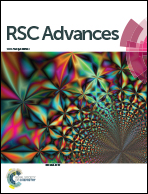A multiple model approach for evaluating the performance of time-lapse capsules in trapping heavy metals from water bodies†
Abstract
Adsorption by ion-exchange resins has been widely used as a cost-effective method for removing numerous hazardous materials, particularly heavy metals, from aqueous solutions. For effectively detecting the illegal discharge of industrial wastewater containing heavy metals, we developed “time-lapse capsules” to trap metallic ions from water bodies. Despite recent progress in the development of time-lapse capsules, a fundamental understanding was still needed to unravel the adsorption behavior of different heavy metals for further improvement of the design and scale-up of the capsule. In this study, three different approaches, viz., response surfaces (from the statistical point of view), time-dependent diffusion-controlled models (from the kinetic point of view), and adsorption isotherms (from the equilibrium point of view), were utilized to evaluate the effect of operating factors on the adsorption of heavy metals from watershed using time-lapse capsules. The obtained results indicated that the key parameters, such as adsorption rate constant, diffusivity, and maximum adsorption capacity, could provide insights into the basis of design criteria.



 Please wait while we load your content...
Please wait while we load your content...